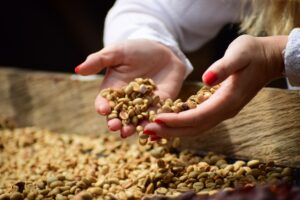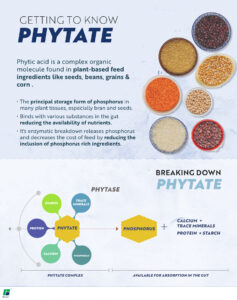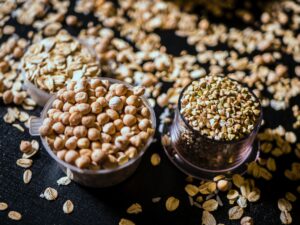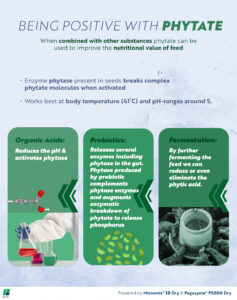It is important to reduce the negative impacts of phytate in feed when looking to achieve precision nutrition and efficient animal diets. The feed industry has evolved rapidly, with science and innovation driving greater understanding of animal biology, feed composition, and nutrition. Learning more about phytate and its interactions in the animal, we have come to understand it as a source of valuable nutrients. Feed efficiency, animal welfare and ultimately profitability are all affected by phytate.
Getting to know Phytate:
It is a known fact that Phytic acid is a chelated organic molecule which binds with vital nutrients like minerals, vitamins, and amino acids that animals could have absorbed from intestine and used in body. Hence it is considered as an anti-nutritional factor in feed. We find phytate in most plant-based feed ingredients like seeds, beans, grains and corn.
The Chemistry behind Phytate:
Phytic acid is a six-fold dihydrogen phosphate ester of inositol, also called inositol hexakisphosphate or inositol polyphosphate. It can form complexes with metals or proteins and therefore reduce their bioavailability in the gastrointestinal tract. Phytate or phytic acid is the principal storage form of phosphorus in many plant tissues, especially bran and seeds.
The basic principle of phytic acid is to protect the seeds from sprouting in unfavourable environments. It is usually found right next to or in the peel. In favourable environmental conditions, specially in the presence of water phytate breaks and releases phosphorus required for sprouting of seeds.
Enzymatic break down of phytate in feed results in improving availability and absorption of essential minerals like phosphorus and other trace minerals.
Negative Effect
The effect of the phytate inside our body are mostly negative, as it chelates minerals. It binds strongly to nutrients such as calcium, magnesium, zinc, iron, vitamin B3 and does not allow the body to use these. Phytate also affects efficacy of digestive enzymes. In tests outside of the body it has been seen that it strongly diminishes the ability of amylase to do its job and break down starch. It also seems to affect pepsin and trypsin, enzymes that our body uses to break down proteins.
Positive Effect
Phytate is also able to bind radioactive substances and heavy metals. By doing so it can help us eliminate them through bowel movements. However, there are other, healthier ways of eliminating heavy metals.
Phytate can also act as a type of antioxidant and thereby eliminate some free radicals. Phytate contains phosphorus. The enzymatic breaking of phytate releases phosphorus and decreases cost of feed by reducing the inclusion of phosphorus rich ingredients like di-calcium phosphate etc.
How can we reduce the amount of phytate and can get positive benefits?
Enzyme phytase breaks complex phytate molecule and makes the phosphorus and other nutrients available for animals to use. Phytase is already present in the seeds, but to be activated it needs water. It works best at temperatures that are a little higher than the body temperature (41°C) and pH-ranges around 5, which is a slightly acidic environment.
Phytase becomes inactive at temperatures higher than 55ºC (131ºF). It can even be destroyed if the seed (grain) is grounded so that the temperature in the grinding process rises above 55ºC (131ºF).
Phytase also becomes inactive if it is frozen or stored during prolonged periods. Though it is not practically possible in animal feed manufacturing, this method could be used wherever suitable, in high value frozen food.
A better understanding of the phytate molecule in recent years has lead to the realization that novel phytases have benefits beyond phosphorus release. Phytases have been shown to reduce the anti-nutrient effects of phytate in animal diets by degrading it, thereby, increasing the availability of energy and amino acids. This provides the potential for phytases to further reduce the cost of feed, particularly when the price of energy and protein/amino acids in diets is high.
Apart from using phytase, several other methods could be explored as combined strategies along with regular usage of phytase in feed.
Organic acid:
Adding organic acid in diet may reduce the pH of the feed. It helps in activating phytase to break phytate molecules.
Probiotics:
It has been seen that probiotics, especially lactobacillus, tends to produce phytase. Adding probiotic in feed is an increasing trend which releases several enzymes including phytase in gut. Phytase produced by probiotic complements phytase enzymes and augments enzymatic break down of phytate to release phosphorus.
Fermentation:
By further fermenting our food we can often greatly reduce or even eliminate the phytic acid.
Formulating feed considering phytate content in feed ingredient is another way to reduce the presence of phytate in feed. High phytate exhibits negative impacts on intestine and reduces the performance. On the other hand, using phytase along with probiotic and acidifier would be a combined strategy to explore bound nutrients, especially phosphorus and other trace minerals.
References:
Famularo G et al, “Probiotic lactobacilli: an innovative tool to correct the malabsorption syndrome of vegetarians?”, Medical Hypotheses 2005 65(6):1132–5.
Davidsson L, 2003, “Approaches to Improve Iron Bioavailability from Complementary Foods’, Journal of Clincal Nutrition, 133:1560S-1562S
Anna Ptak et al., 2015, Phytase Modulates Ileal Microbiota and Enhances Growth Performance of the Broiler Chickens, https://doi.org/10.1371/journal.pone.0119770






